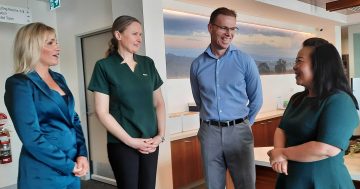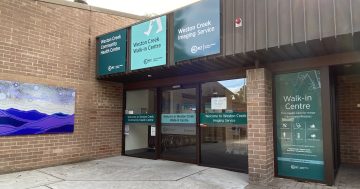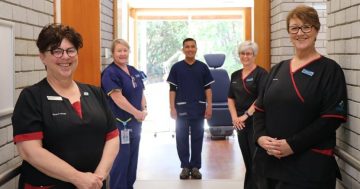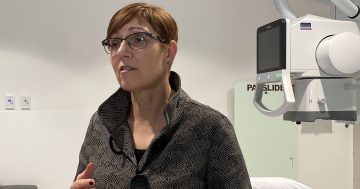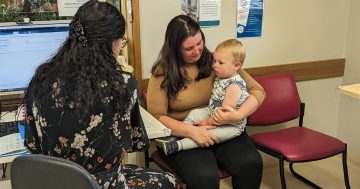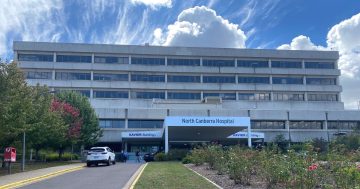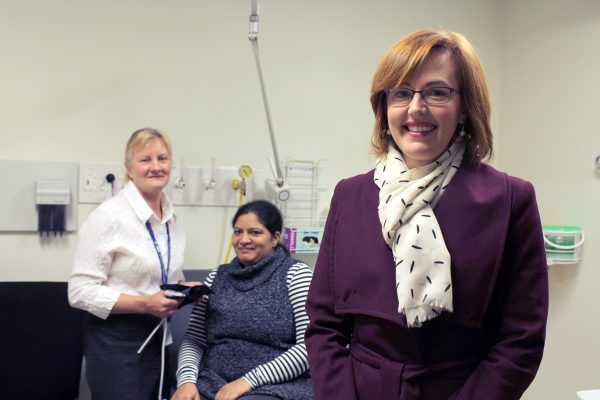
ACT Health Minister Meegan Fitzharris at one of the ACT’s nurse-led walk-in centres. She is being urged to reconsider opening a new centre in Gungahlin.
The AMA is urging the ACT Government to consider alternatives to its popular nurse-led walk-in centres before pressing on with plans to establish more of them in the boom suburbs of Gungahlin and Weston Creek/Molonglo.
The move comes as the centres come under fire from a Canberra doctor who claims the cost and patient numbers do not justify the coming expansion of the program to Gungahlin.
Dr Thinus van Rensburg has been conducting a running battle with Health Minister Meegan Fitzharris and in an open letter accuses her of “spending millions of dollars from a limited tax resource on an unproven and un-needed venture’’.
AMA ACT branch CEO Peter Somerville agrees, saying the centres are a colossal waste of money but concedes that the established centres in Belconnen and Tuggeranong are here to stay.
“We’ve been talking to the government about what problem it is they’re trying to solve,” he said.
This year’s ACT Budget committed $14 million over five years to a new centre connected to the Gungahlin Community Health Centre and a scoping study in Weston Creek. Construction of the new centre in Gungahlin is due to start early next year and be open by mid-2018.
However, the AMA was continuing to argue that there were cheaper and more effective alternatives to the present model that could be adopted and the Government should not charge ahead in Gungahlin.
Mr Somerville said that at more than $200 occasion of service, the walk-in centres were significantly more expensive than a GP and the low-level work being done did not alleviate pressures on hospital emergency departments.
“We do understand that in Canberra a lot of people say they have difficulties finding a GP or finding a bulkbilling GP,’’ Mr Somerville said.
But it was a complex matter and there were no circumstances where 100 per cent of patients were not bulk-billed, he said.
“Most practices bulk-bill young families, concession card holders, and older people,’’ Mr Somerville said. “GPs make adjustments for that.’’
Mr Somervile said one suggestion from the AMA was to integrate the walk-in model and its nursing resources into general practice through a tender system.
“GPs could bid for these additional resources on the basis that you’ll locate in a certain part of the ACT like Molonglo or if they are already in existence and close to it,’’ he said.
GPs would commit to extended hours and open on a walk-in basis, with the nurse treating patients or triaging them through to the doctor.
“Here’s a way to integrate those nursing skills into that general practice, and many already have those nursing resources,’’ Mr Somerville said.
He said Capital Health Network was also conducting projects about how nursing resources could be integrated into primary care.
Dr van Rensburg says in his letter that the Gungahlin centre would be within walking distance of about a dozen existing GP clinics that are mixed billing or fully bulkbilling and have daily openings for patients.
He says the Minister’s response that presentations to the walk-in centres continued to increase was unsupported and called for more evidence.
“The Quarterly ACT Public Health Services report showed in 2015-6 that ED presentations continued to increase every single year and that the two walk-in centres saw an average of about 2600 patient combined each month, averaging only three patients per hour at each site,” Dr van Rensburg says.
“One in five patients were seen with colds and 1000 people had their earwax seen to.
“We have no information regarding current costs and efficiency measures but there is no reason to not believe that these two clinics are every bit as inefficient as the 2011 review showed – and still only sees the equivalent of what three to four fully qualified GPs could easily do in a normal working day.’’
A spokesperson for the Minister said there had not been any further formal evaluation of the walk-in centres since 2011 when the Australian Primary Health Care Research Institute completed an independent evaluation, but performance was continually monitored by ACT Health, including presentations, costs and a range of quality and safety indicators.
Mr Somerville said the AMA would continue talking to the Minister but it appeared the Government was politically wedded to the model.
“We urge the Government: you’ve already spent enough money on this, it’s significantly costly please consider alternatives.”
The Minister’s spokesperson said the walk-in centres were a genuine alternative to EDs for people with minor illness or injury particularly with their extended opening hours and availability on weekends and public holidays.
People with serious or complex care needs were advised to still seek medical care from a GP or the ED.
The spokesperson said walk-in centres provided a no-cost service in a market that had the lowest bulk billing rates in Australia and were important to support the health needs of disadvantaged Canberrans, as well as provide health care after hours and on weekends, when there were very limited alternative options available.
Walk-in centres aimed to complement GP services by providing referrals and updates back to a patient’s GP or specialist for the patient’s ongoing care.
The spokesperson said that the Minister had spoken with a range of stakeholders and was aware that some doctors had raised issues with the model since its inception. She would continue to have discussions, including with the AMA, and is open to suggestions on how the model could be improved, the spokesperson said.
ACT Health and Capital Health Network is organising an information forum at the Gungahlin Health Centre on 31 August and will soon invite local health providers to attend.
Have you been treated at a nurse-led walk-in centre? Do you think they do a good job and are worth the cost to the taxpayer?












